Over the years, my wife, Joni, and I had traveled throughout France, usually staying a couple of weeks looking for the right place for our retirement. Each time, realizing even more that our retirement would eventually lead us back to France. But where?
We had looked at Paris, delightful and exciting, but ultimately too expensive. We had previously stayed in Bordeaux and Toulouse, both possibilities. But, we had not yet found the place that ticked all of the boxes. Location, transportation in and out to visit friends in Sweden, Germany, Spain, Norway, Iceland, and the UK, with as much ease as possible was a priority.
Weather was an issue as well. We had lived in an area in the U.S. that had four distinct seasons, but the winters were cold, so we wanted a more moderate climate. Community was important as well, not just an expat community but an energetic group that welcomed expats. Access to great food was a requirement and the availability of a university, a plus.
In our search, we headed for Languedoc Roussillon, and the Gulf of Lion, where we investigated Carcassonne, Narbonne, Nice, Eze, and Aix en Provence.
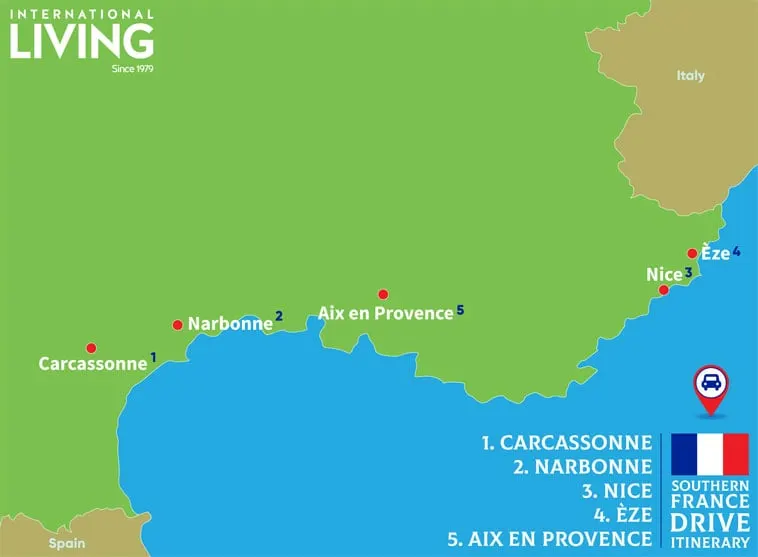
Our strategy was to seek out people in these communities that could show and tell us what life was like in their community. We tried, where possible, to stay in either B&B’s or small hotels operated by the proprietor, using their experience in the community. This gave us an opportunity to get to know neighborhoods, local restaurants, and places off the beaten path. First stop, Carcassonne.
Day 1-4 Carcassonne
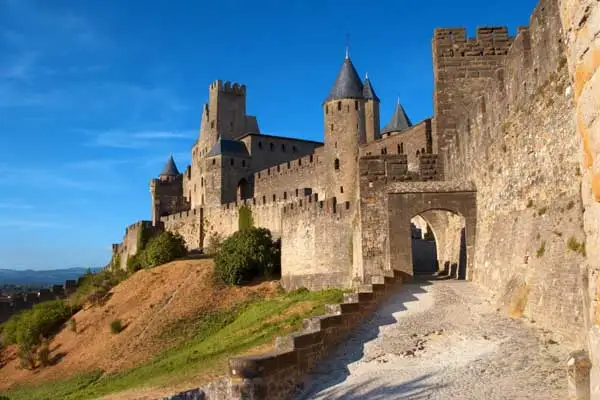
A golfing friend of mine recommended Carcassonne. His sister lived there for fifteen years and was willing to give us the tour, and as it turned out, invite us to a Saturday market and pub-crawl. So, we toured the city, learned where the expats lived, and visited the markets.
Carcassonne’s biggest draw is the La Cite Citadel and Chateau, which was built in the 12th century. They stand over the village below with huge moats, ramparts, and narrow gates. The village of La Cite contains the Basilique St Nazaire where the Siege Stone hangs commemorating the war with the Crusaders in 1209. Le Chateau, positioned within the ramparts of the La Cite, is well worth the tour.
We booked three days of our stay in the Hotel De La Cite. A 10-minute taxi ride from the train station left us at the cemetery drawbridge entrance to La Cite village. From there a small hotel shuttle picked us up and traversed the narrow cobblestone pathway to the hotel. It is a charming hotel that opens on the back to a rampart walk to the Chateau. No traffic other than an occasional delivery vehicle is allowed in the Citadel. The cobblestone streets wind through the village which is full of restaurants, art and crafts stores, and features truffles, foie gras, and some of the best cassoulet (a hot bean, duck, and sausage dish)we have ever tasted.
On our first night in La Cite, we met our new friends at the hotel, and they took us to a local restaurant, La Pas Sage, in the village where we had the most marvelous cassoulet, for just under $9. We planned our itinerary for the next day meeting at the central plaza in the town below where we would join our new friends at the central market and pub “The Florian”.
The next morning, around 10:30 a.m, we left the castle for the walk to the town below. After a steep descent across the moats, through a charming park to a footbridge across the Aude River, we made our way onto the main promenade heading toward the central market. The town center was filled with modern retailers, restaurants, and pubs. We arrived at the central market filled with vendors selling colorful vegetables, meats, cheese, and seafood from the Mediterranean. The prices were far better than in the U.S. and remarkably less than in Paris, fresh mussels were just $3 euro per kilo and tomatoes $1.99 per kilo.
Our friends introduced us to their friends from Ireland, London, the U.S., and France. They all seemed excited to meet prospective new residents, and shared their views on living in Carcassonne. In general, they all loved the smallness of the village. They said the weather was good in general but windy in the fall. The rents and cost of real estate was moderate. Good apartments could be had for $890 a month and condos could be purchased for $76,000 to $150,000.
Then off to the finale, Les Halles, a central market filled with local food vendors, a bar, and a restaurant. By the time we got there, it was close to 2 p.m. Most of the food vendors had closed but the pub continued until around 3 p.m. with loud music and locals drinking and eating.
We moved the next day closer to the town center to Carcassonne B&B, run by two UK citizens, Mike and Peter. They shared some recommendations for restaurants and museums and suggested we look at Narbonne as it is closer to the Mediterranean and only a short train ride away.
Travel Time to Narbonne: 50 minutes
Day 5 Narbonne
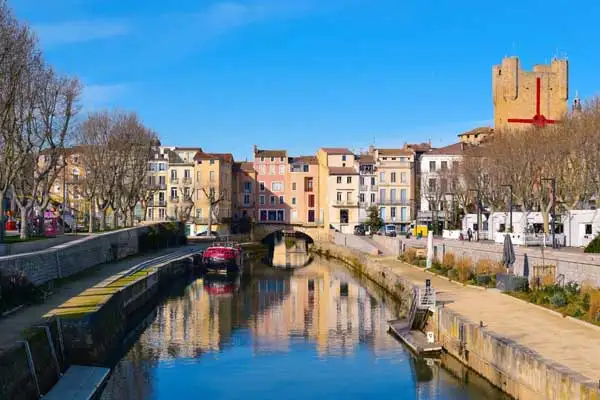
We arrived in Narbonne and made our way, as is our custom, to Les Halles for lunch and to get the lowdown on living in Narbonne.
Narbonne is a young and growing wine region. On our way we found the Roman Horrreum, a huge underground warehouse that serviced the Narbonne port until the estuary filled with silt and ended the value of the harbor in the 15th century. The Canal de la Robine leads to the Gulf of Lion at Port la Nouvelle.
We made new friends at lunch and they told us they rented their two-bedroom condo for $730 a month and older condos in midtown could be found for even less.
Narbonne’s history was somewhat understated. We toured the Cathedral Saint- Just et Saint-Pasteur, connected to the Palais des Archeveques at the center of Narbonne. There are more artifacts, sculptures, tapestries, and documents here than one could absorb in a couple of hours. Although there are several museums worthy of a visit in Narbonne, we spent our time walking the Canal de la Robine.
We also enjoyed looking out at the leisure boats in the canal and imagining the short ride to the Gulf of Lion. We found Narbonne comfortable and a possibility for our retirement. The weather in Narbonne was better than Carcassonne, and the proximity to the Mediterranean much more attractive. Moreover, the cost of living in Narbonne was also less.
But we had more to see. Next stop Nice.
Travel Time to Nice: 3-4 hours
Day 6-7 Nice
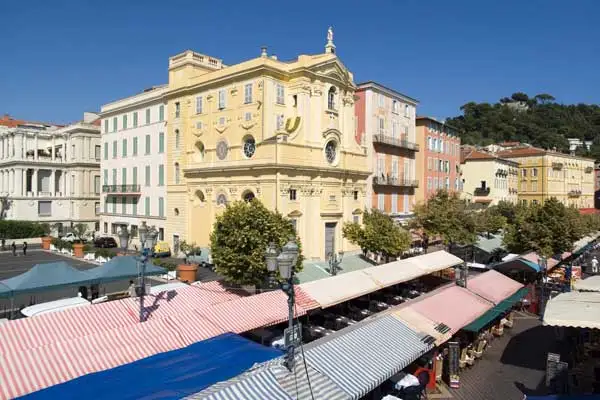
We did not expect that Nice in its cosmopolitan splendor would be a place where we would want to settle, but it was on our way to Aix en Provence, and we wanted to explore Eze, so we decided to go there. We found our small hotel, Victor Hugo, in easy walking distance from the train station. It was a small nine-room hotel run by the owner, Gerard, and his four-legged companion, Cosette. Gerard gave us directions to all the neighborhoods that he thought would be nice for a retired couple and provided a list of all the sights to see.
Nice has a broad range of food. Seafood dominates and we followed Gerald’s suggestion for a great restaurant called Spity, on the beach, within walking distance of the hotel, just off the promenade des Anglais, built in the 1830s. The seafood was extraordinary. After lunch we walked to the Russian Church, a popular tourist site with lots of history.
During our three days in Nice we also toured the famous flower market, the Cimiez district, the Notre-Dame de-Cimiez, the Musee Matisse, and the Musee Chagall—all worth seeing. We found the old town a fascinating blend of International restaurants—worth the walk if only to smell the dishes cooking.
We found some apartments that would have been perfect for us, along Victor Hugo Boulevard in the $1,100 price range. Although we enjoyed Nice, with its architecture and history, it was too busy for us. Perhaps it is better suited for the three-day tourist than the long-term retiree.
Travel Time to Eze: 30 minutes
Day 8 Eze
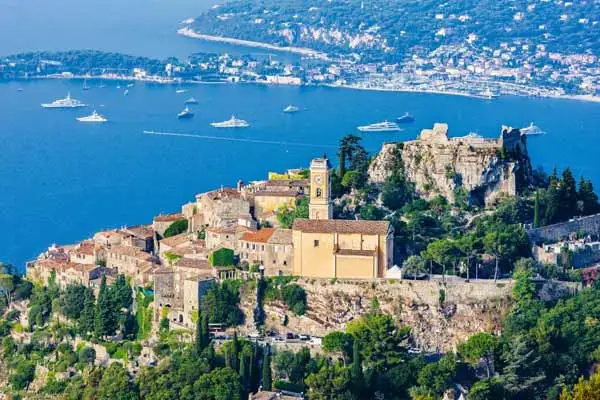
Eze is a charming village perched high above the Mediterranean Sea, over-looking Monaco. Its history is a turbulent one, over the years dominated by the Romans, and then, annexed by the French in 1860.
Carved out of the mountain it occupies, the oldest building is the Chapelle de la Saints Croix, completed in 1306. Eze features art galleries, gift shops, hotels, and restaurants at every turn of its cobbled alleyways. Hotels cater to the rich and famous with views that are incredible. We investigated having lunch at one of the finest restaurants in the village called Chateau de la Chevre d'Or, and figured we could have a glass of wine each with a goats cheese salad and bread for $280. We thought better of it and walked down the hill to Gascogne Café for a $16 special of the day.
Before we left, we decided to follow the suggestion of our hotel owner and find the cemetery and the secret corridor to the back of the cemetery overlooking the Monaco coast. We found our way and true to his word, it was a spectacular view. We were alone in the cemetery, but couldn’t imagine a more peaceful place to reside watching the rich and famous come and go.
Eze is a great day trip. You can get there by train, but as easily by bus, about a 20-minute ride. It’s good to know as well, that your tram ticket bought for the tram in Nice, can be used for the bus to Eze if used within an hour after exiting the tram.
Travel Time to Aix en Provence: 2 hours
Day 9-14 Aix en Provence
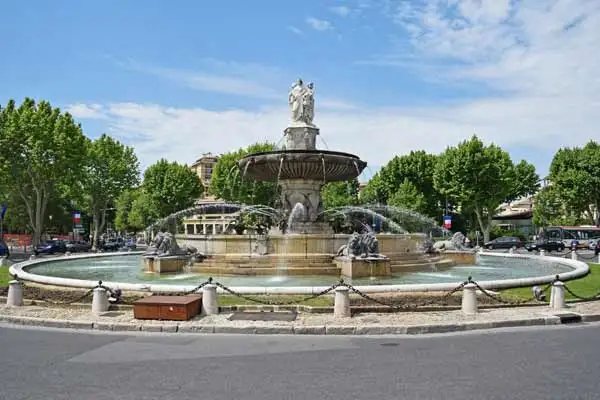
Aix en Provence, like so much of southern France, was founded by the Romans in 103 BC. The city of 1,000 fountains became the capital of Provence in the 12th century.
We came to Aix en Provence for the weather, and its location to cities and villages such as Avignon, Chateau de Pape, Arles, Marseille, Cassis, and Toulon, with ferry service to Corsica.
We stayed in a small one-bedroom apartment 100 yards from the Musee Granet. In the museum, we enjoyed an impressive collection of the artist Cézanne. Paul Cézanne was born in Aix en Provence and his studio is not far from town. Aix en Provence is more famous for its dry rose wines and Provençal food than its architecture. We were only two blocks from Cours Mirabeau, full of great restaurants and every Tuesday, Thursday, and Saturday a famous market full of fresh cheese, meats, vegetables, clothes, and nearly everything you could need.
Provence’s food is so different from any other place in France and is thought to be the origin of the niçoise salad, bouillabaisse, (Marseille would beg to differ), and ratatouille. Infused with olive oil and garlic, the food seems closer to Italian cuisine than of France, but it is truly magnificent.
Aix in Provence is a modern city with the most upscale Apple store we have ever seen, an array of eateries, and shopping malls within walking distance of old town, and our apartment. Exploring old town was an incredible journey. We found restaurants from every country in the world.
We did see a couple of apartments in the old town that were very modest but livable in the $620 to $840 range, and in the latter case it included utilities.
The University of Aix-Marseille has consolidated with the University of the Mediterranean, and the Paul Cezanne University, to become the largest student population of all the Universities in France. We visited the linguistics department and found an array of language classes including French for foreigners. The French University system is largely tuition-free if you qualify and the thought of taking a French class in France was very appealing.
Our stay in Aix en Provence lasted five days. We could have spent much more time exploring the surrounding area and plan on our next trip to include Chateau du Pape, Arles, and a longer visit to Avignon.
Aix en Provence ticked all the boxes for us. A modern city, with a university, street markets, access to high-speed trains, proximity to the Mediterranean, reasonable rents, and a good cost of living.
We will return during the wine harvest in September to explore even more.
Related Articles
Moving to France Will Be the Best Move You’ve Ever Made
An Overview of Traditions and Culture in France
Enjoy Traveling in France to See Some of Europe’s Finest Sites
